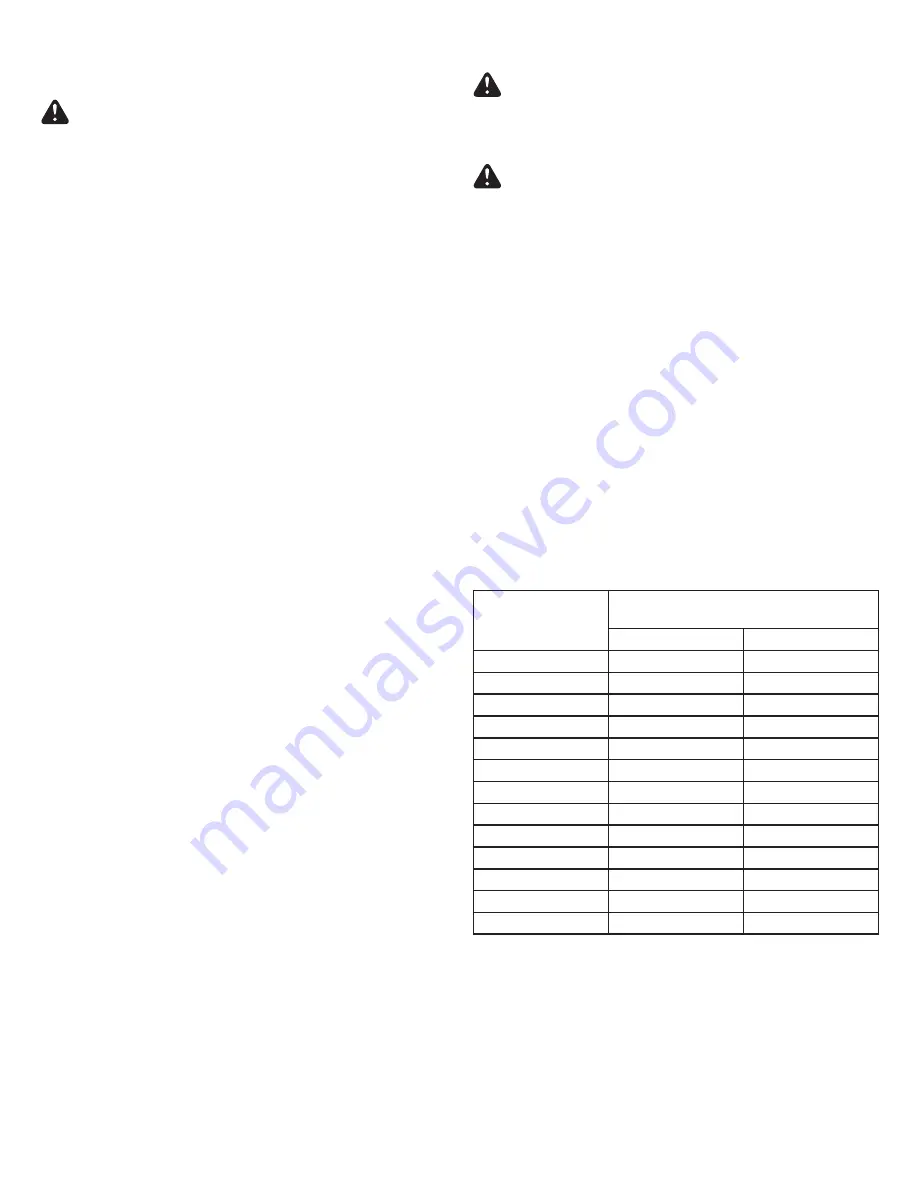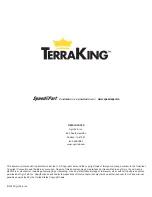
5
INSTALLATION
INSTALLING BALLAST
CAUTION:
Avoid Injury!
Machine can become unstable
when operating with attachment. Ballast is required when the
attachment is installed.
When the attachments is removed, also remove any ballast
that was added to the machine.
Use only attachments and accessories recommended by the
manufacturer.
Refer to your tractors operator’s manual to determine the required front
ballast weight. When filled with liquid, the 45-gallon sprayer weights
620 lbs (281 Kg).
ATTACHING SPRAYER TO TRACTOR
1. Park machine safely and on level ground.
2. Lower tractor lift link to lowest position.
3. Mount sprayer on 3-point hitch and install lynch pins.
4. Attach sprayer harness to switch harness making sure harness is
clear of any pinch points.
5. Level sprayer by adjusting the top link and draft link on the
3-point hitch.
ATTACHING SPRAYER TO TRACTOR WITH QUICK HITCH
1. Install bushing set (sold separately), Terra-King part number
TK95029, on to sprayer.
2. With sprayer on level ground, lower 3-point hitch aligning the center
hook just below the top pin on the sprayer.
3. Back tractor into position and ensure all three connection points are
aligned.
4. Raise 3-point hitch and ensure all three pins are fully engaged with
the quick hitch.
5.
Lock lower connections on quick hitch following the manufacture's
directions.
6. Level sprayer by adjusting the top link and draft link on the
3-point hitch.
7. Attach sprayer harness to switch harness making sure harness is
clear of any pinch points.
REMOVAL AND STORAGE
REMOVING SPRAYER FROM TRACTOR
1. Park machine safely and on level ground.
2. Empty the sprayer tank.
3. Lower the sprayer to the ground.
4. Disconnect the sprayer harness from the switch harness and store
on top of sprayer.
5. Disconnect sprayer from 3-point hitch, refer to quick hitch
manufacture's instructions if using quick hitch.
6. Remove any added ballast from tractor.
OPERATION
CAUTION:
Connect to a 12 V battery only.
PSI PRESSURE GAUGE
Wrap threads of pressure gauge with sealant tape before attaching to
the sprayer.
CAUTION:
Do not overtighten. Only hand tighten the pressure
gauge to the sprayer valve.
CALIBRATING THE SPRAYER
When spraying with boom, sprayer must be calibrated to ensure proper
spray coverage and to combat over-application or under-application.
The calibration process consists of three steps:
1. Calculate speed of tractor.
2. Determine nozzle size and consult calibration chart for desired or
instructed gallon per acre (GPA).
3. Set pressure using relief valve.
CALCULATING THE SPEED
It is important to determine what speed the tractor will be traveling
while spraying. Even if tractor has a speedometer, it is still
recommended that speed be checked for accuracy. Perform the
following steps to determine speed:
1.
Measure a 200 or 300 foot distance on a field or surface similar to
where sprayer will be used.
2. Drive tractor with half-full sprayer across measured distance at
a constant and comfortable speed for spraying. There can be no
changes in speed while measuring time.
3. Determine amount of time, in seconds, it takes to travel the
measured distance.
4. Speed can be determined with the following equation:
speed (mph) = (distance (ft) x 60) / (time (sec) x 88) or by
consulting the following table.
Speed in MPH
Time (sec) required to travel
a distance of:
200 ft
300 ft
1.0
136
205
1.5
91
136
2.0
68
102
2.5
55
82
3.0
45
68
3.5
39
56
4.0
34
51
4.5
30
45
5.0
27
41
5.5
25
37
6.0
23
34
6.5
21
31
7.0
19
29
USEFUL FORMULAS
GPA = Gallons per Acre
GPM = Gallons per Minute
MPH = Miles per Hour
GAL/1000 sq ft = Gallons per 1000 sq ft
W = Nozzle spacing in inches
GPM Per Nozzle = GPA x MPH x W / 5940
GPM Per Nozzle = GAL/1000 sq ft x MPH x W / 136
GPA = 5940 x GPM (Per Nozzle) / MPH x W
GPA = Gallons per 1000 sq ft / 0.023
GAL/1000 sq ft = 136 x GPM (Per Nozzle) / MPH x W






































